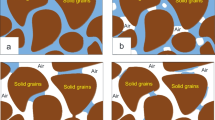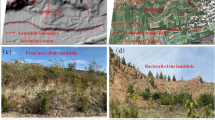Abstract
The shear strength parameters (SSPs) of slip soil, which control the stability and evolution process of a landslide, exist some uncertainty that should be characterized and considered significantly in the stability analysis. In this paper, a typical reservoir landslide with double-sliding zones is taken as a case study. The statistical characteristics of SSPs in sliding zones are first analyzed using the geostatistical method and the Copula method, especially the spatial variation features, scales of fluctuation, and correlation of SSPs. Then, random variable models for the shallow sliding zone and nonstationary random field models with various vertical scales of fluctuation for the deep sliding zone are established separately. Finally, by employing the nonintrusive stochastic finite element program, the fluid–solid numerical simulation of a real hydrological year is carried out to obtain the landslide displacement, element failure probability, and factor of safety. The results demonstrate that incorporating spatial variability into the SSPs of slip soil led to a fundamental change in landslide stability and deformation. Our study provides some references for the reliability assessment of reservoir landslides considering the uncertainties and the spatial variation characteristics of SSP in the sliding zone.


















Similar content being viewed by others
References
Tang HM, Wasowski J, Juang CH (2019) Geohazards in the three Gorges Reservoir Area, China-Lessons learned from decades of research. Eng Geol 261:105267–105267
Tang HM, Zou ZX, Xiong CR, Wu YP, Hu XL, Wang LQ, Li CD (2015) An evolution model of large consequent bedding rockslides, with particular reference to the Jiweishan rockslide in Southwest China. Eng Geol 186:17–27
Tang HM, Li CD, Hu XL, Su AJ, Wang LQ, Wu YP, Criss RE, Xiong CR, Li YA (2015) Evolution characteristics of the Huangtupo landslide based on in situ tunneling and monitoring. Landslides 12(3):511–521
Wang JE, Su AJ, Liu QB, Xiang W, Yeh HF, Xiong CR, Zou ZX, Zhong C, Liu JQ, Cao S (2018) Three-dimensional analyses of the sliding surface distribution in the Huangtupo No. 1 riverside sliding mass in the Three Gorges Reservoir area of China. Landslides 15:1425–1435
Cui DS, Wang S, Chen Q, Wu W (2021) Experimental Investigation on Loading-Relaxation Behaviors of Shear-Zone Soil. Int J Geomech 21(4):06021003
Wen BP, Aydin A, Duzgoren-Aydin NS, Li YR, Chen HY, Xiao SD (2007) Residual strength of slip zones of large landslides in the Three Gorges area. China Eng Geol 93(3–4):82–98
Jiang JW, Xiang W, Rohn J, Zeng W, Schleier M (2015) Research on water–rock (soil) interaction by dynamic tracing method for Huangtupo landslide, Three Gorges Reservoir, PR China. Environ Earth Sci 74(1):557–571
Lu S, Tang HM, Zhang YQ, Gong WP, Wang LQ (2018) Effects of the particle-size distribution on the micro and macro behavior of soils: fractal dimension as an indicator of the spatial variability of a slip zone in a landslide. Bull Eng Geol Environ 77(2):665–677
Tan QW (2019) Study on the structural capacity of sliding zone soil based on the in-situ triaxial test and its application – taking the Huangtupo landslide as an example. China University of Geoscience (in Chinese)
Miao FS, Wu YP, Li LW, Tang HM, Xiong F (2020) Weakening laws of slip zone soils during wetting–drying cycles based on fractal theory: a case study in the Three Gorges Reservoir (China). Acta Geotech 15:1909–1923
Wen BP, Aydin A (2003) Microstructural study of a natural slip zone: quantification and deformation history. Eng Geol 68(3–4):289–317
Zhao LH, Zuo S, Lin YL, Li L, Zhang YB (2016) Reliability back analysis of shear strength parameters of landslide with three-dimensional upper bound limit analysis theory. Landslides 13(4):711–724
El-Ramly H, Morgenstern NR, Cruden DM (2002) Probabilistic slope stability analysis for practice. Can Geotech J 39(3):665–683
Phoon KK, Kulhawy FH (1999) Characterization of geotechnical variability. Can Geotech J 36(4):612–624
Li DQ, Qi XH, Phoon KK, Zhang LM, Zhou CB (2014) Effect of spatially variable shear strength parameters with linearly increasing mean trend on reliability of infinite slopes. Struct Saf 49:45–55
Li DQ, Xiao T, Cao ZJ, Phoon KK, Zhou CB (2016) Efficient and consistent reliability analysis of soil slope stability using both limit equilibrium analysis and finite element analysis. Appl Math Model 40(9–10):5216–5229
Jiang SH, Li DQ, Zhang LM, Zhou CB (2014) Slope reliability analysis considering spatially variable shear strength parameters using a non-intrusive stochastic finite element method. Eng Geol 168:120–128
Huang J, Lyamin AV, Griffiths DV, Krabbenhoft K, Sloan SW (2013) Quantitative risk assessment of landslide by limit analysis and random fields. Comput Geotech 53:60–67
Griffiths DV, Huang J, Fenton GA (2015) Probabilistic slope stability analysis using RFEM with non-stationary random fields. In: Schweckendiek T, van Tol F, Pereboom D, van Staveren M, Cools P (eds) Geotechnical safety and risk V. IOS Press, Amsterdam, The Netherlands, pp 704–709
Jiang SH, Huang J (2016) Efficient slope reliability analysis at low-probability levels in spatially variable soils. Comput Geotech 75:18–27
Jiang SH, Huang JS (2018) Modeling of non-stationary random field of undrained shear strength of soil for slope reliability analysis. Soils Found 58(1):185–198
Jiang SH, Liu X, Huang JS (2020) Non-intrusive reliability analysis of unsaturated embankment slopes accounting for spatial variabilities of soil hydraulic and shear strength parameters. Eng Comput. https://doi.org/10.1007/s00366-020-01108-6
Jiang SH, Papaioannou I, Straub D (2018) Bayesian updating of slope reliability in spatially variable soils with in-situ measurements. Eng Geol 239:310–320
Yang HQ, Zhang LL, Xue JF, Zhang J, Li X (2019) Unsaturated soil slope characterization with karhunen–loève and polynomial chaos via bayesian approach. Eng Comput 35(1):337–350
Jiang SH, Huang J, Qi XH, Zhou CB (2020) Efficient probabilistic back analysis of spatially varying soil parameters for slope reliability assessment. Eng Geol 271:105597
Wu YP, Cheng C, He GF, Zhang QX (2014) Landslide stability analysis based on random-fuzzy reliability: taking Liangshuijing landslide as a case. Stoch Env Res Risk A 28(7):1723–1732
Miao FS, Wu YP, Xie YH, Yu F, Peng LJ (2017) Research on progressive failure process of Baishuihe landslide based on Monte Carlo model. Stoch Env Res Risk A 31(7):1683–1696
Tang XS, Li DQ, Rong G, Phoon KK, Zhou CB (2013) Impact of copula selection on geotechnical reliability under incomplete probability information. Comput Geotech 49:264–278
Tang XS, Li DQ, Zhou CB, Phoon KK (2015) Copula-based approaches for evaluating slope reliability under incomplete probability information. Struct Saf 52:90–99
Li C, Tang HM, Han DW, Zou ZX (2019) Exploration of the creep properties of undisturbed shear zone soil of the Huangtupo landslide. Bull Eng Geol Environ 78(2):1237–1248
Li B, Tang HM, Gong WP, Tan QW, Zhang GC (2018) Stability analysis of sliding mass I at riverside of Huangtupo landslide in one hydrological year. J Eng Geol 26(s1):167–173 (in Chinese)
O’Connor AJ, Kenshel O (2012) Experimental evaluation of the scale of fluctuation for spatial variability modeling of chloride-induced reinforced concrete corrosion. J Bridge Eng 18(1):3–14
Onyejekwe S, Kang X, Ge L (2016) Evaluation of the scale of fluctuation of geotechnical parameters by autocorrelation function and semivariogram function. Eng Geol 214:43–49
Ni WD, Tang HM, Hu XL, Wu YP, Su AJ (2013) Research on deformation and stability evolution law of huangtupo riverside slump-mass No. 1. Rock Soil Mech 34(10):2961–2970 (in Chinese)
HIGH (2002) Detailed investigation report of Huangtupo landslide in Badong County, Hubei. Hubei Institute of Geological Hazard, Jingzhou (in Chinese)
CISPD (2009) Detailed investigation report of Huangtupo landslide in Badong County, Hubei. Changjiang Institute of Survey, Planning, Design (in Chinese)
Hua S (2015) Genetic mechanism of multi-stages sliding and evolution law of the Huangtupo landslide in the Three Gorges Reservoir Area. China University of Geoscience (in Chinese)
Luo C, Yin KL, Chen LX, Jian WX (2005) Probability distribution fittingand optimization of shear strength parameters in sliding zone along horizontal-stratum landslides in wanzhou city. Chin J Rock Mech Eng 24(9):1588–1593 (in Chinese)
Li YY, Yin KL, Chai B, Zhang GR (2008) Study on statistical rule of shear strength parameters of soil in landslide zone in three gorges reservoir area. Rock Soil Mech 29(5):1419–1418 (in Chinese)
Gundogdu KS, Guney I (2007) Spatial analyses of groundwater levels using universal kriging. J Earth Syst Sci 116(1):49–55
Brus DJ, Heuvelink GB (2007) Optimization of sample patterns for universal kriging of environmental variables. Geoderma 138(1–2):86–95
Xue Y, Wu YP, Miao FS, Li LW, Liao K, Ou GZ (2020) Effect of spatially variable saturated hydraulic conductivity with non-stationary characteristics on the stability of reservoir landslides. Stoch Env Res Risk A 34(2):311–329
Zheng YR, Zhao SY (2004) Application of strength reduction FEM in soil and rock slope. Chin J Rock Mech Eng 23(19):3381–3388 (in Chinese)
Huang MS, Jia CQ (2009) Strength reduction FEM in stability analysis of soil slopes subjected to transient unsaturated seepage. Comput Geotech 36(1–2):93–101
Yang GH, Zhong ZH, Fu XD, Zhang YC, Wen Y, Zhang MF (2014) Slope analysis based on local strength reduction method and variable–modulus elasto-plastic model. J Cent South Univ 21:2041–2050
Acknowledgements
This research is supported by the National Natural Science Foundation of China (Grant No.41977244), the National Key Research and Development Program of China (Grant No. 2017YFC1501301), and the National Natural Science Foundation of China (Grant No.42007267). The authors are grateful to the colleagues in our laboratory for their constructive comments and assistance.
Author information
Authors and Affiliations
Corresponding author
Additional information
Publisher's Note
Springer Nature remains neutral with regard to jurisdictional claims in published maps and institutional affiliations.
Rights and permissions
About this article
Cite this article
Xue, Y., Miao, F., Wu, Y. et al. Application of uncertain models of sliding zone on stability analysis for reservoir landslide considering the uncertainty of shear strength parameters. Engineering with Computers 38 (Suppl 4), 3057–3076 (2022). https://doi.org/10.1007/s00366-021-01446-z
Received:
Accepted:
Published:
Issue Date:
DOI: https://doi.org/10.1007/s00366-021-01446-z




